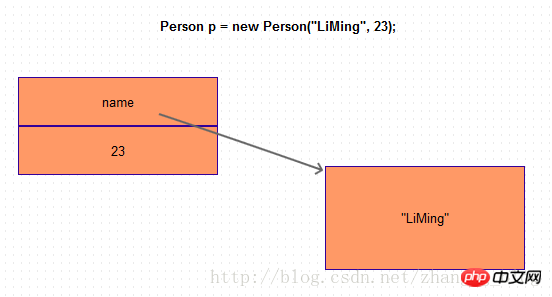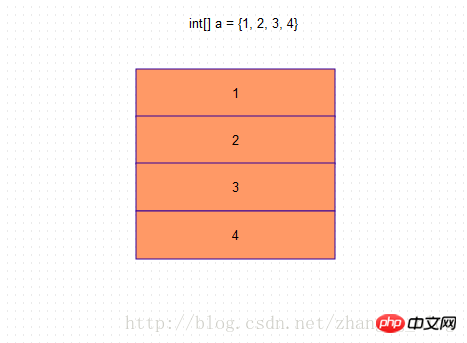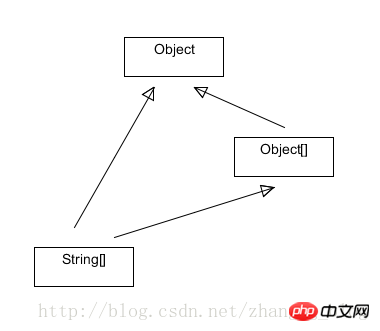
Array is a data type that basically exists in all languages. It represents a set of data of the same type, has a fixed length, and occupies a continuous space in memory. In languages such as C and C++, the definition of arrays is concise and clear, but in Java there are indeed some confusing features. This article will try to analyze these characteristics
#Are arrays in Java objects?
Java and C++ are both object-oriented languages. When using these languages, we can directly use the standard class library, or we can use object-oriented features such as composition and inheritance to build our own classes, and build our own classes based on them. Create object. So, should we consider this question: In object-oriented languages, are arrays objects?
To determine whether an array is an object, first clarify what an object is, which is the definition of an object. At a high level, an object is an instance created from a class and represents a specific individual in a class of things. Objects have various properties and have some specific behaviors . At a lower level, from the perspective of a computer, an object is a memory block in the memory. This memory block encapsulates some data, which is the various attributes defined in the class. Therefore, the object is used to encapsulate data. . The following is the representation of a Person object in memory:

##Note:
string object. A strict distinction is made here between references and objects.
So in Java, does an array meet the above conditions? At a high level, an array is not a specific individual of a certain type of thing, but a collection of multiple individuals. Then it should not be an object. From a computer perspective, an array is also a memory block that also encapsulates some data. In this case, it can also be called an object. The following is the representation of an array in memory:
int[] a = new int[4]; //a.length; //对属性的引用不能当成语句 int len = a.length; //数组中保存一个字段, 表示数组的长度 //以下方法说明数组可以调用方法,java中的数组是对象.这些方法是Object中的方法,所以可以肯定,数组的最顶层父类也是Object a.clone(); a.toString();
It can basically be concluded that an array in Java is also an object. It has some basic characteristics of other objects in Java: it encapsulates some data, can access properties, and can also call methods. So, arrays are objects.
In C++, although the array encapsulates data, the array name is just a pointer, pointing to the first element in the array, with neither attributes nor methods to call. As shown in the following code:int main(){
int a[] = {1, 2, 3, 4};
int* pa = a;
//无法访问属性,也不能调用方法。
return 0;
}Types of arrays in Java
based on the Person class, the type of this object is Person. So what is the type of array? Look at the following code:
int[] a1 = {1, 2, 3, 4};
System.out.println(a1.getClass().getName());
//打印出的数组类的名字为[I
String[] s = new String[2];
System.out.println(s.getClass().getName());
//打印出的数组类的名字为 [Ljava.lang.String;
String[][] ss = new String[2][3];
System.out.println(ss.getClass().getName());
//打印出的数组类的名字为 [[Ljava.lang.String;public class int[] {
// ...
// ...
// ...
}The virtual machine automatically creates an array type. The array type can be used as a built-in type of Java, the same as the 8 basic data types. The naming rules for this type are as follows:
* 每一维度用一个[表示;开头两个[,就代表是二维数组。
* [后面是数组中元素的类型(包括基本数据类型和引用数据类型)
在java语言层面上,s是数组,也是一个对象,那么他的类型应该是String[],这样说是合理的。但是在JVM中,他的类型为[java.lang.String。顺便说一句普通的类在JVM里的类型为 包名+类名,也就是全限定名。同一个类型在java语言中和在虚拟机中的表示可能是不一样的。
Java中数组的继承关系
上面已经验证了,数组是对象,也就是说可以以操作对象的方式来操作数组。并且数组在虚拟机中有它特别的类型。既然是对象,遵循Java语言中的规则 -- Object是上帝, 也就是说所有类的顶层父类都是Object。数组的顶层父类也必须是Object,这就说明数组对象可以向上直接转型到Object,也可以向下强制类型转换,也可以使用instanceof关键字做类型判定。 这一切都和普通对象一样。如下代码所示:
//1 在test1()中已经测试得到以下结论: 数组也是对象, 数组的顶层父类是Object, 所以可以向上转型
int[] a = new int[8];
Object obj = a ; //数组的父类也是Object,可以将a向上转型到Object
//2 那么能向下转型吗?
int[] b = (int[])obj; //可以进行向下转型
//3 能使用instanceof关键字判定吗?
if(obj instanceof int[]){ //可以用instanceof关键字进行类型判定
System.out.println("obj的真实类型是int[]");
}Java中数组的另一种“继承”关系
如下代码是正确的,却很容易让我们疑惑:
String[] s = new String[5]; Object[] obja = s; //成立,说明可以用Object[]的引用来接收String[]的对象
Object[]类型的引用可以指向String[]类型的数组对象? 由上文的验证可以得知数组类型的顶层父类一定是Object,那么上面代码中s的直接父类是谁呢?难道说String[]继承自Object[],而Object[]又继承自Object? 让我们通过反射的方式来验证这个问题:
//5 那么String[] 的直接父类是Object[] 还是 Object? System.out.println(s.getClass().getSuperclass().getName()); //打印结果为java.lang.Object,说明String[] 的直接父类是 Object而不是Object[]
由代码可知,String[]的直接父类就是Object而不是Object[]。可是Object[]的引用明明可以指向String[]类型的对象。那么他们的继承关系有点像这样:

这样的话就违背了Java单继承的原则。String[]不可能即继承Object,又继承Object[]。上面的类图肯定是错误的。那么只能这样解释:数组类直接继承了Object,关于Object[]类型的引用能够指向String[]类型的对象,这种情况只能是Java语法之中的一个特例,并不是严格意义上的继承。也就是说,String[]不继承自Object[],但是我可以允许你向上转型到Object[],这种特性是赋予你的一项特权。
其实这种关系可以这样表述:如果有两个类A和B,如果B继承(extends)了A,那么A[]类型的引用就可以指向B[]类型的对象。如下代码所示:
public static class Father {
}
public static class Son extends Father {
}
//6 下面成立吗? Father是Son的直接父类
Son[] sons = new Son[3];
Father[] fa = sons; //成立
//7 那么Son[] 的直接父类是Father[] 还是 Object[] 或者是Object?
System.out.println(sons.getClass().getSuperclass().getName());
//打印结果为java.lang.Object,说明Son[]的直接父类是Object上面的结论可以扩展到二维数组和多维数组:
Son[][] sonss = new Son[2][4]; Father[][] fathers = sonss;
上面的代码可以这样理解:
将Father[][]数组看成是一维数组, 这是个数组中的元素为Father[],将Son[][]数组看成是一维数组, 这是个数组中的元素为Son[],因为Father[]类型的引用可以指向Son[]类型的对象,所以,根据上面的结论,Father[][]的引用可以指向Son[][]类型的对象。
数组的这种用法不能作用于基本类型数据:
int[] aa = new int[4]; //Object[] objaa = aa; //错误的,不能通过编译
这是错误的, 因为int不是引用类型,Object不是int的父类,在这里自动装箱不起作用。但是这种方式是可以的:
Object[] objss = {"aaa", 1, 2.5};这种情况下自动装箱可以工作,也就是说,Object数组中可以存放任何值,包括基本数据类型。
Java为什么会为数组提供这样一种语法特性呢?也就是说这种语法有什么作用?编写过Android中Sqlite数据库操作程序的同学可能发现过这种现象,用一个Object[]引用接收所有的数组对象,在编译SQL语句时,为SQL语句中的占位符提供对应的值。
db.execSQL("INSERT INTO person VALUES (NULL, ?, ?)", new Object[]{person.name, person.age});所以这种特性主要是用于方法中参数的传递。如果不传递数组,而是依次传递各个值,会使方法参数列表变得冗长。如果使用具体的数组类型,如String[],那么就限定了类型,失去了灵活性。所以传递数组类型是一种比较好的方式。但是如果没有上面的数组特性(如果有两个类A和B,如果B继承(extends)了A,那么A[]类型的引用就可以指向B[]类型的对象),那么数组类型就只能通过Object类型接收,这样就无法在方法内部访问或遍历数组中的各个元素。如下代码:
private static void test3() {
String[] a = new String[3];
doArray(a);
}
private static void doArray(Object[] objs){
}
private static void doArray1(Object obj){
//不能用Object接收数组,因为这样无法对数组的元素进行访问
// obj[1] //错误
//如果在方法内部对obj转型到数组,存在类型转换异常的风险
// Object[] objs = (Object[]) obj;
}
private static void doArray2(String[] strs){
//如果适用特定类型的数组,就限制了类型,失去灵活性和通用性
}
private static void doArray3(String name, int age, String id, float account){
//如果不适用数组而是依次传递参数,会使参数列表变得冗长,难以阅读
}到此为止,数组的特性就总结完了。上文中加粗的部分为重要结论。下面贴出整个源码:
源码
package com.pansoft.zhangjg.testarray;
public class ArrayTest {
/**
* @param args
*/
public static void main(String[] args) {
test1();
test2();
test3();
}
/**
* 数组具有这种特性:
* 如果有两个类A和B,如果B继承(extends)了A,那么A[]类型的引用就可以指向B[]类型的对象
* 测试数组的特殊特性对参数传递的便利性
*/
private static void test3() {
String[] a = new String[3];
doArray(a);
}
private static void doArray(Object[] objs){
}
private static void doArray1(Object obj){
//不能用Object接收数组,因为这样无法对数组的元素进行访问
// obj[1] //错误
//如果在方法内部对obj转型到数组,存在类型转换异常的风险
// Object[] objs = (Object[]) obj;
}
private static void doArray2(String[] strs){
//如果适用特定类型的数组,就限制了类型,失去灵活性和通用性
}
private static void doArray3(String name, int age, String id, float account){
//如果不适用数组而是依次传递参数,会使参数列表变得冗长,难以阅读
}
/**
* 测试数组的集成关系, 并且他的继承关系是否和数组中元素的类型有关
*/
private static void test2() {
//1 在test1()中已经测试得到以下结论: 数组也是对象, 数组的顶层父类是Object, 所以可以向上转型
int[] a = new int[8];
Object obj = a ; //数组的父类也是Object,可以将a向上转型到Object
//2 那么能向下转型吗?
int[] b = (int[])obj; //可以进行向下转型
//3 能使用instanceof关键字判定吗?
if(obj instanceof int[]){ //可以用instanceof关键字进行类型判定
System.out.println("obj的真实类型是int[]");
}
//4 下面代码成立吗?
String[] s = new String[5];
Object[] obja = s; //成立,说明可以用Object[]的引用来接收String[]的对象
//5 那么String[] 的直接父类是Object[] 还是 Object?
System.out.println(s.getClass().getSuperclass().getName());
//打印结果为java.lang.Object,说明String[] 的直接父类是 Object而不是Object[]
//6 下面成立吗? Father是Son的直接父类
Son[] sons = new Son[3];
Father[] fa = sons; //成立
//7 那么Son[] 的直接父类是Father[] 还是 Object[] 或者是Object?
System.out.println(sons.getClass().getSuperclass().getName());
//打印结果为java.lang.Object,说明Son[]的直接父类是Object
/**
* 做一下总结, 如果A是B的父类, 那么A[] 类型的引用可以指向 B[]类型的变量
* 但是B[]的直接父类是Object, 所有数组的父类都是Object
*/
//8 上面的结论可以扩展到二维数组
Son[][] sonss = new Son[2][4];
Father[][] fathers = sonss;
//将Father[][]数组看成是一维数组, 这是个数组中的元素为Father[]
//将Son[][]数组看成是一维数组, 这是个数组中的元素为Son[]
//因为Father[]类型的引用可以指向Son[]类型的对象
//所以,根据上面的结论,Father[][]的引用可以指向Son[][]类型的对象
/**
* 扩展结论:
* 因为Object是所有引用类型的父类
* 所以Object[]的引用可以指向任何引用数据类型的数组的对象. 如:
* Object[] objs = new String[1];
* Object[] objs = new Son[1];
*
*/
//9 下面的代码成立吗?
int[] aa = new int[4];
//Object[] objaa = aa; //错误的,不能通过编译
//这是错误的, 因为Object不是int的父类,在这里自动装箱不起作用
//10 这样可以吗?
Object[] objss = {"aaa", 1, 2.5};//成立
}
/**
* 测试在java语言中,数组是不是对象
* 如果是对象, 那么他的类型是什么?
*/
private static void test1() {
int[] a = new int[4];
//a.length; //对属性的引用不能当成语句
int len = a.length; //数组中保存一个字段, 表示数组的长度
//以下方法说明数组可以调用方法,java中的数组是对象.这些方法是Object中的方法,所以可以肯定,数组的最顶层父类也是Object
a.clone();
a.toString();
/**
* java是强类型的语言,一个对象总会有一个特定的类型,例如 Person p = new Person();
* 对象p(确切的说是引用)的类型是Person类, 这个Person类是我们自己编写的
* 那么数组的类型是什么呢? 下面使用反射的方式进行验证
*/
int[] a1 = {1, 2, 3, 4};
System.out.println(a1.getClass().getName());
//打印出的数组类的名字为[I
String[] s = new String[2];
System.out.println(s.getClass().getName());
//打印出的数组类的名字为 [Ljava.lang.String;
String[][] ss = new String[2][3];
System.out.println(ss.getClass().getName());
//打印出的数组类的名字为 [[Ljava.lang.String;
/**
* 所以,数组也是有类型的,只不过这个类型不是有程序员自己定义的类, 也不是jdk里面
* 的类, 而是虚拟机在运行时专门创建的类
* 类型的命名规则是:
* 每一维度用一个[表示;
* [后面是数组中元素的类型(包括基本数据类型和引用数据类型)
*
* 在java语言层面上,s是数组,也是一个对象,那么他的类型应该是String[],
* 但是在JVM中,他的类型为[java.lang.String
*
* 顺便说一句普通的类在JVM里的类型为 包名+类名, 也就是全限定名
*/
}
public static class Father {
}
public static class Son extends Father {
}
}【相关推荐】
1. 特别推荐:“php程序员工具箱”V0.1版本下载
2. Java免费视频教程
3. 全面解析Java注解
The above is the detailed content of Little-known special features of Java arrays. For more information, please follow other related articles on the PHP Chinese website!




